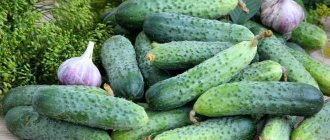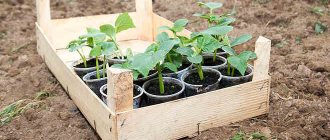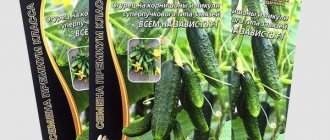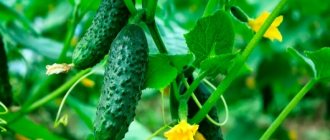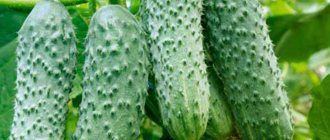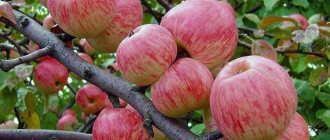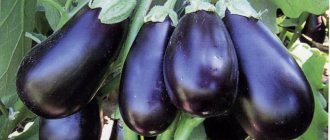The first generation hybrid “Emerald Placer F1” was bred in Russia. This means that along with high yield and quality of fruits, it also has excellent adaptation to the peculiarities of the local climate.
You can grow cucumbers not only in the country, but also right on your windowsill. They develop remarkably well in such conditions and produce a good harvest.
Yield hybrid Emerald placer F1 - description
This hybrid is parthenocarpic, and this alone determines the presence of many positive characteristics in the Emerald Placer:
· powerful stem development;
· abundant fruiting;
· immunity to many “traditional” cucumber diseases.
This cucumber does not need insects for pollination; it grows and bears fruit well both in a greenhouse and in the open air.
ON A NOTE! When grown in greenhouses and under shelters, the yield of Emerald Placer is up to 24-25 kg per m2.
This is an early ripening cucumber hybrid; in a greenhouse, with appropriate agricultural technology, the first fruits can be harvested as early as 40-42 days (the seedlings were planted in mid-May, and the greens were harvested by mid-June). In the middle zone and to the south it can be grown on ridges without shelters; in the northwestern regions, in the Urals and to the east, cultivation in greenhouses is recommended.
The plant is powerful and vigorous, but the branching is weak. In a hybrid, the side shoots have a limited length, and this allows you to avoid dense plantings even without forming a bush. The leaves are medium sized, bright green in color. Each node usually produces two or three ovaries.
The fruits of the Emerald Placer are beautiful - dark green, white-thorned, with large tubercles. The average length of Zelentsy is 10 cm; there are specimens of greater length – up to 12 cm.
Cucumbers hanging on the bush are pleasing to the eye, the plant looks very picturesque (see photo). The taste of cucumbers is pleasant, aromatic, the pulp is very dense, there are few seeds.
Hybrid cucumbers are ideal for canning (they can be picked at the gherkin stage) and, of course, are delicious fresh.
The hybrid has proven itself well in various areas; those summer residents who have grown it at least once do not refuse the Emerald Placer in the future.
Description and characteristics of the variety
Emerald placer F1 belongs to early hybrids.
Fruiting begins 38-42 days after germination and lasts until autumn. The hybrid was bred in 2013 and entered into the State Register in 2015. Intended for cultivation in regions with different climatic conditions. The distributor is
The bushes are distinguished by their strength and strength of shoots and grow according to the indeterminate type. The lateral branches are limited in growth and quite compact. The foliage is moderate. The leaves are long-petiolate with a notch and a wrinkled surface.
Flowering occurs according to the female type. The hybrid is parthenocarpic and does not require pollinators. In 1 node it forms 2-4 greens.
The fruits have the following properties:
- length 10-12 cm;
- diameter 3-4 cm;
- cylindrical, elongated shape;
- weight 100-120 g;
- ribbing is weak;
- emerald coloring;
- tubercles of medium height;
- pubescence moderate white;
- the taste is sweet and fresh;
- the flesh is elastic and crispy.
Advantages and disadvantages of the “Emerald Placer”
The main advantages of the “Emerald Placer”:
· Strong immunity;
· Abundant fruiting;
· Ability to grow in any conditions;
· Excellent marketability and taste of fruits;
· Parthenogenesis.
The disadvantages of a hybrid are related to its dimensions:
· For growing in closed conditions you will need a high greenhouse;
· When cultivated in open ground, the plant is strongly influenced by wind loads;
· Complex agricultural technology.
Infections
Despite the strong immunity of cucumber, plants of the variety can be affected by root rot, fusarium and ascochyta blight.
Root rot
Fungal pathology, root rot, appears in patches on the bushes of the variety. The first signs of infection of the cucumber hybrid begin to appear immediately after transplanting the seedlings Emerald scattering f1: the tops become sluggish, and the roots, if you look at them, darken. Also, with the disease, thinning of the stem and yellowing of the lower leaves of the plants are observed. Chemicals help fight the disease:
- "Previkur";
- "Alirin-B";
- "Gamair".
Fusarium
Fusarium wilt can develop on Emerald Placer plants for a long time, remaining unnoticed. Omission of pathological spores is formed as a result of weakened roots of cucumber bushes. You can spot an enemy by the following signs:
- Wilting of tops;
- Darkening of stem vessels;
- Thinning of the stem;
- Yellowing of foliage.
To combat fusarium, Emerald Placer bushes are treated with chemical and biological substances “Quadris”, “Baktofit”, “Gimnast” and “Trichodermin”.
Ascochyta blight
Another name for the pathology is black rot. The infection appears in the form of a weakened cucumber bush. Often, ascochyta blight develops on greenhouse plants and appears before the appearance of a cucumber. The main signs of infection are the covering of green plants with watery spots, which dry out and die over time. The affected bushes of the Emerald Placer must be removed, and the remaining plants of the variety must be treated with a solution of chalk and copper, vitriol and urea, or a Bordeaux mixture.
Planting and caring for cucumbers Emerald Placer F1
The variety is recommended to be grown in seedlings. It is best to calculate the time for sowing seeds for seedlings yourself, always taking into account the climate.
Three- or four-week-old seedlings can be transplanted indoors in mid- or late May. Emerald Placer seedlings can be planted in open ground 2 - 3 weeks later.
In order for the plant to develop well, it needs warmth, so try to allocate well-lit areas for the beds. But in the south, when growing outdoors, it is still better to plant cucumbers in a place where light partial shade protects from the hot sun during the midday period.
Planting pattern: 30 - 40 cm between bushes, 70 cm width between rows. After transplanting, each plant must be tied to a trellis. The variety loves watering. But it is worth remembering that to moisturize you need to use only warm water. As fertilizing, universal balanced fertilizers containing microelements necessary for growth and fruiting are used. When growing in a greenhouse, humidity levels should be controlled. To do this, use ventilation, but only on the leeward side, and loosening the soil after the next watering.
Many vegetable growers are just beginning to get acquainted with the Emerald Placer. But those who have already grown the hybrid have an excellent opinion about it.
The yield will not fail either in open ground or in closed ground. Immunity is high, so the number of chemical treatments can be minimized. In addition, the variety can be safely grown on the balcony, although at home you will have to control the growth of the main stem.
Some vegetable growers who cultivate cucumbers for sale have already tried the hybrid in commercial cultivation and were also pleased with the results. There are no obvious disadvantages of the variety. The only inconvenience is the inability to collect seeds yourself. Therefore, you will have to purchase seed material regularly.
Tips for the garden, vegetable garden and flower garden
Caring for raspberries in the spring at the dacha in an open area
Tree peony care and cultivation in the Moscow region
How to prepare yeast as fertilizer for seedlings
Care instructions
Cucumbers are not only a heat-loving crop, but also a crop that requires special care. Emerald scattering gherkins allow you to harvest a large and tasty harvest if the bushes are watered and fed in a timely manner, and the soil is loosened.
Watering works
Water the cucumbers once every 5 days. Watering processes are recommended to be carried out in the evening, when the sun sets below the horizon. All procedures are performed with warm water, which has been infused throughout the day in the sun. It is advisable to water the bushes of the variety strictly at the root.
Weeding
Weed the beds with cucumbers Emerald placer f1 before watering. This procedure allows you to remove a dense layer of soil and pass irrigation liquid to the roots of the plants. It is advisable to weed the soil using a fork so as not to damage the root system of the bushes.
Fertilizer
It is necessary to fertilize beds with Emerald Placer plants after watering processes. Fertilizers are applied every 3 weeks, alternating organic and mineral components. You can also feed the soil with potassium, potassium sulfate and nitrophoska.
Reviews about the variety from those who planted
Valery: I don’t have any problems with growing. If you plant them correctly from the beginning in well-fertilized soil, when warm weather has already settled, then the bushes will grow further on their own; all that remains is to water them. I rarely prune; they have a strong main stem that tends upward, and the lateral ones are weak and sparse.
The harvest is huge, I plant 2 bushes per square meter and collect 10 kilos, or even 12, from each. All cucumbers are bright green, with beautiful pimples and thin skin, almost no seeds. It’s nice to eat them either fresh or canned, they are crispy, without voids, sweetish and juicy.
Marina: It self-pollinates, so I only grow it in a greenhouse, it’s more reliable and the yield is greater. I consider the variety to be unpretentious, it is strong, does not get sick, and seedlings are always accepted. 1.5 months after transplanting into the ground, I remove the greens. Loves warmth. I live in the south, but I don’t risk planting it in April, we have recurring frosts, and for it it’s death.
I plant in warm soil after the May holidays, the harvest appears on the 10th of June. I make sure that the fruits do not grow more than 10 cm; I partially remove them when they grow to 7 cm in order to tighten the gherkins for the winter. Placer has no noticeable shortcomings; I have been growing this particular variety for many years now.
Anna: The variety is young, so purchasing seed material is sometimes difficult. Seeds obtained independently are not suitable for propagation. The bushes have moderate climbing and an average number of leaves, but their growth potential is unlimited. Plants easily grow up to 2 meters in height.
Horizontal cultivation is not possible, only on trellises. Pollinating insects are not required for the formation of ovaries; there are no difficulties with cultivation under cover. The taste is excellent. The pulp is very juicy, with a sweetish aftertaste. Bitterness is absent genetically.
Description
An indeterminate type plant that does not limit growth to a height of 2 meters. It is characterized by weak branching and the formation of growth-limited determinant lateral shoots. The foliage is good. The leaves are healthy, richly green, medium in size, long-petiolate, entire, with a slightly wrinkled, rough surface, a deep notch at the base and a sharp, slightly drawn-out (especially for young leaves) apex. The type of flowering of the Emerald Placer is female. The cucumber blooms profusely; the female flowers are formed in bunches, usually 2-3 pieces, but sometimes more. The first flowers may appear on the first or second node. The fruits are short, cylindrical in shape, 10-12 cm long, 3.5-4 cm in diameter. The ribbing is not pronounced, the surface is covered with large tubercles, but they are located infrequently. The color is bright, emerald green, as the name suggests. The pubescence is white. The State Register notes the taste qualities as good. The taste is sweetish, the flesh is tender, moderately dense, crispy, and does not contain even a hint of bitterness. The seeds are at the stage of milky ripeness, so they are practically undetectable when consumed. Average weight 110-130 grams.
